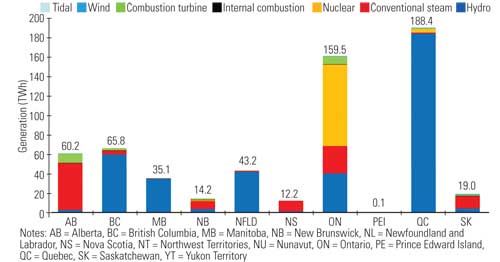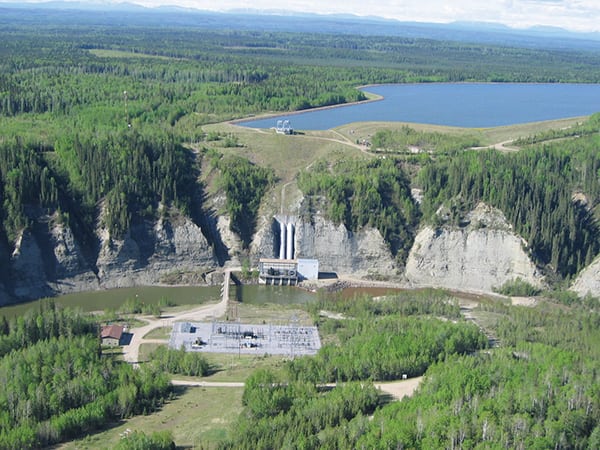Reducing emissions from the electricity sector continues as a primary transformational goal of government policy-makers, and the private and public companies managing electricity generation in Canada. Impressive progress has been made.
National Overview
Emissions from electricity generation made up just 11% of Canada’s total in 2014. Over 79% of generation is non-emitting: hydropower (63%), nuclear (13%), and renewables (3%).
More significantly, emissions from generation have been declining steadily from 120 million metric tons (Mt) in 2000 to 78 Mt in 2014. Complete elimination of coal-fired generation from Ontario’s generation mix and lower demand due to the 2008 economic downturn have been primary contributors.
GHG Mitigation Policy—National and Provincial
Canada has implemented the full spectrum of climate policy tools: carbon regulation, carbon pricing, cap-and-trade regimes within Canada and linked to U.S. markets, significant investment in new technology, and policy directives to green the generation mix.
In October 2016, the federal government announced plans to implement a pan-Canadian carbon tax, beginning in 2018. Each jurisdiction will be able to choose between a direct price on carbon or a cap-and-trade system. All revenues will flow back to the province or territory.
Canada’s provinces have the lead role in all things related to energy in keeping with their constitutionally assigned ownership of resources within their boundaries. Not surprisingly, a variety of emissions reduction policies have emerged; separate pathways, but with a common goal.
In 2009, Nova Scotia established greenhouse gas (GHG) emissions regulations imposing caps on the electricity sector. As of 2014, Nova Scotia had already reduced emissions 17% below 1990 levels, and it was on track to reach 24% by 2020. An internal-to-Nova Scotia cap-and-trade system will retain revenues and GHG reductions within the province.
In Ontario, elimination of coal-fired generation was set as a provincial policy goal in 2004, driven by health concerns. Coal-fired generation was eliminated in late 2014, North America’s single largest emissions reduction initiative. The 2009 Green Energy and Economy Act provided for a succession of feed-in-tariff programs incenting renewables, which now contribute 6% of generation.
To sustain nuclear power’s 60% share of generation, plant refurbishments are in progress. Refurbishment of the four units at Bruce A was completed successfully in 2012. Refurbishment of the remaining units will commence in 2020. At Darlington, work is now underway on a ten-year project to refurbish its four units. Ontario’s cap-and-trade program came into effect in July 2016, linked with California and Québec.
Following implementation of a sophisticated carbon regulation regime in 2008, a first for Canada, Alberta launched its Climate Leadership Plan in November 2015. Features are complete phase-out of coal-fired generation by 2030, to be replaced by generation from renewables and natural gas, and a target of 30% from renewables by 2030. Of the province’s 18 coal-fired plants, 12 are scheduled to be taken off-line before 2030. An agreement has been reached between three of the remaining plants and the Alberta government to compensate owners for taking their plants off-line by 2030.
Marking recent technological progress are new electricity storage services in Ontario, based on a variety of storage technologies. Saskatchewan’s world-first CO2 capture facility at SaskPower’s Boundary Dam plant began operation in late 2014, integrated with use of the captured CO2 to enhance oil production at a neighboring oil field and disposal of the remainder in a deep geological formation. To facilitate interprovincial electricity trade, increased interconnection capacity has been installed between Québec and Ontario, and is being considered in other regions as well.
The Path Forward
Do issues remain? For sure: increases in electricity prices, meeting Canada’s 2030 target, and uncertainty about energy trade have emerged as critical issues.
The recent increase in electricity prices has become a hot button issue in jurisdictions in the midst of greening their generation. Expect electricity prices to remain a political issue.
Second, there is a significant gap to be closed to meet Canada’s national target of a 30% reduction in emissions relative to 2005 levels by 2030. According to government projections, annual emissions will at best remain flat at roughly 750 Mt to 2030. To reach the 2030 target, emissions will need to be reduced to 524 Mt, a decrease of more than 225 Mt. Recently-announced policy actions will certainly help meet Canada’s national target.
The impact of the emerging energy policies of the U.S. administration on Canada is unknown at the time of writing (mid-January 2017). Energy markets connecting Canada, the U.S., and Mexico are highly integrated and mutually beneficial.
In addition to the generation story, we will see greater electrification in end-use sectors, particularly in transportation, and the beneficial impacts from utilities’ investment in decentralized generation, smart grid networks, and demand side management.
In closing, Canada’s electricity sector has already made a substantial contribution to GHG reductions, and it will continue to do so as recently announced policies and further actions by electricity providers and distributors roll out. ■
 —Graham Campbell is president of the Energy Council of Canada, which works with members from all energy sectors, and the federal and provincial governments, and serves as Canada’s representative to the World Energy Council.
—Graham Campbell is president of the Energy Council of Canada, which works with members from all energy sectors, and the federal and provincial governments, and serves as Canada’s representative to the World Energy Council.

















